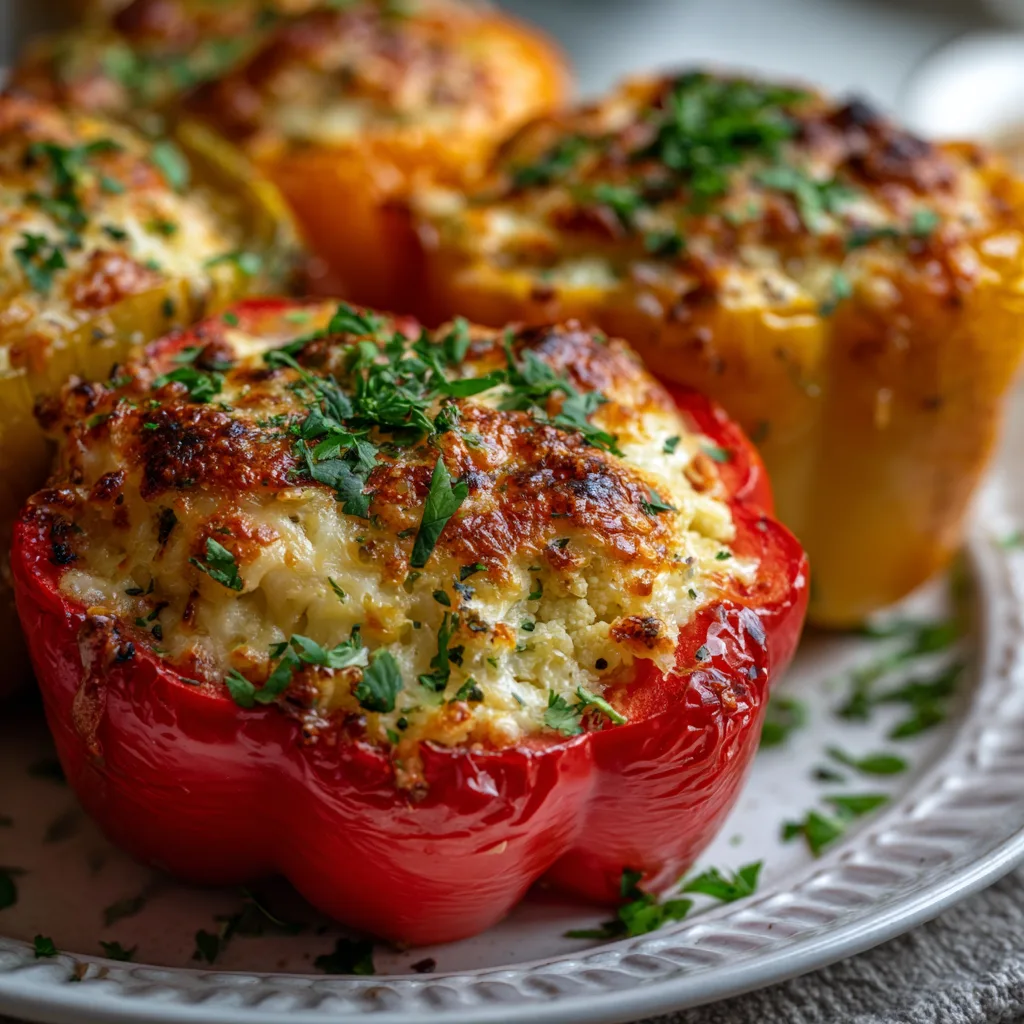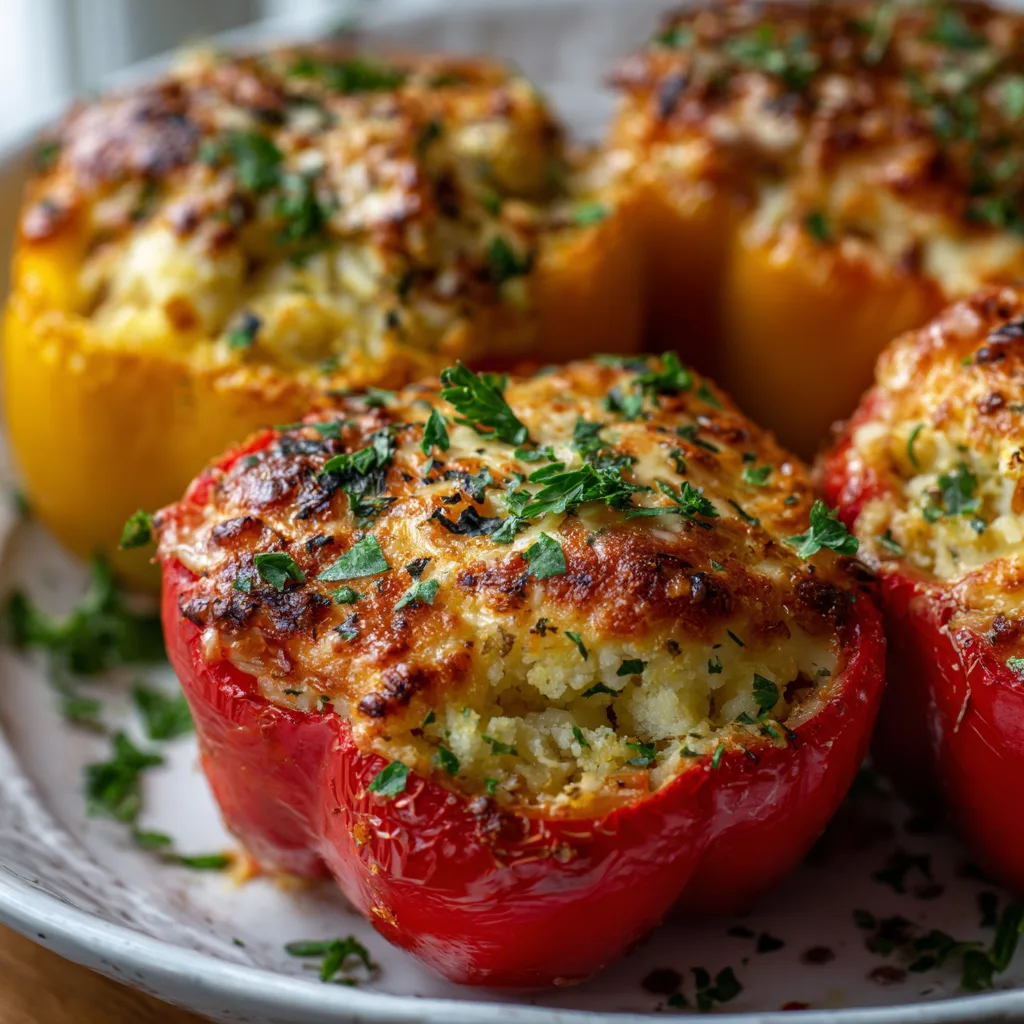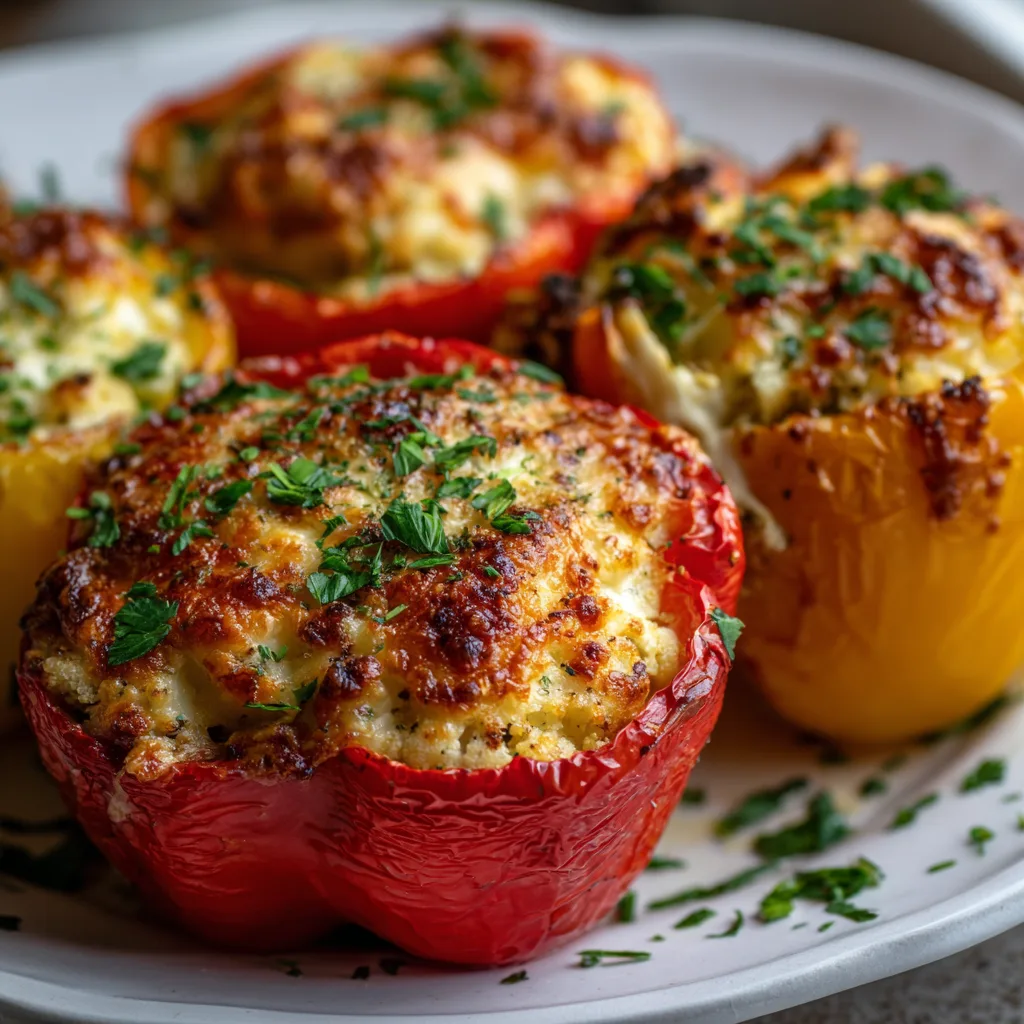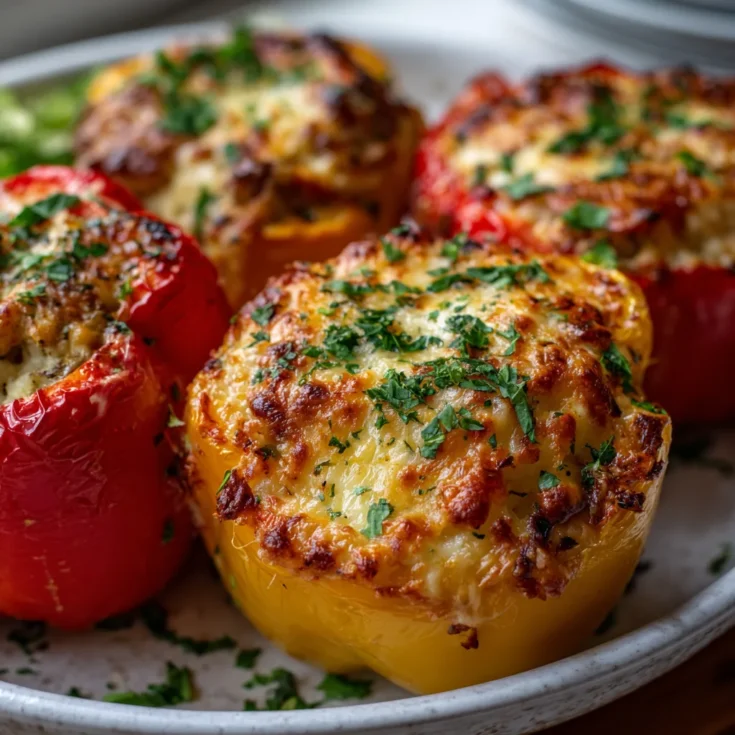Introduction to Low-Carb Cauliflower Stuffed Peppers
Understanding Low-Carb Diets for Better Health
Low-carb diets focus on reducing carbohydrate intake while increasing protein and healthy fats. This approach helps stabilize blood sugar and supports weight management. By cutting down on carbs, many people experience improved energy levels and reduced cravings. Low-carb eating promotes fat burning and can lower the risk of chronic diseases like diabetes and heart conditions. For those aiming to shed pounds or maintain a healthy lifestyle, embracing low-carb meals offers an effective, sustainable path.
The Role of Cauliflower in Low-Carb Cooking
Cauliflower shines as a low-carb superstar thanks to its low calorie and carbohydrate content. Rich in vitamins C and K, fiber, and antioxidants, it supports overall wellness. Its mild flavor and adaptable texture make cauliflower a popular substitute for grains and starchy foods. From cauliflower rice to mash, this vegetable easily replaces higher-carb ingredients, helping keep meals light yet satisfying. Its versatility allows for endless creativity in low-carb cooking.
Why Choose Stuffed Peppers for a Nourishing Dinner
Bell peppers provide a vibrant, nutrient-packed vessel for healthy fillings. Loaded with vitamins A and C, fiber, and antioxidants, they boost immune health and digestion. Stuffed peppers deliver a balanced meal by combining vegetables, proteins, and spices in one dish. They satisfy hunger without overwhelming calories. Additionally, their natural sweetness pairs beautifully with savory fillings, creating a colorful and hearty dinner option that fuels the body while delighting the palate.
Essential Ingredients for Low-Carb Cauliflower Stuffed Peppers
Choosing the Best Bell Peppers: Color and Size Matter
Selecting the right bell peppers sets the foundation for this dish. Red, yellow, and orange peppers offer sweeter flavors, while green peppers add a mild bitterness. Choose firm peppers with smooth skin and avoid any with soft spots or blemishes. Medium to large sizes work best for stuffing, providing enough room for a hearty filling. Beyond taste, bell peppers pack vitamins A and C, antioxidants, and fiber, enhancing both flavor and nutrition.
Mastering Cauliflower Rice: Homemade and Store-Bought Options
Cauliflower rice transforms this dish into a low-carb delight. To make it at home, pulse fresh cauliflower florets in a food processor until they reach a rice-like texture. Lightly steaming or sautéing the rice softens it without adding moisture. For convenience, many stores offer pre-riced cauliflower in the frozen or fresh produce section. Just be sure to drain any excess water before adding it to your filling to avoid sogginess.
Protein Choices: Selecting Your Perfect Low-Carb Filling
Ground beef, turkey, or chicken are popular protein options that provide essential amino acids. Each offers distinct flavors and fat contents. Ground turkey tends to be leaner, making it ideal for calorie-conscious eaters. Beef adds richness and depth, while chicken offers a mild taste that pairs well with various spices. For vegetarian alternatives, consider crumbled tofu, tempeh, or legumes like lentils. These options deliver protein with added fiber and micronutrients.
Boosting Flavor: Onions, Garlic, Herbs, and Spices
Flavor enhancers transform simple ingredients into a savory masterpiece. Sautéing diced onions and minced garlic releases aromatic oils that deepen the filling’s taste. Fresh or dried herbs such as oregano, thyme, and basil add complexity, while spices like paprika, cumin, or chili powder bring warmth and subtle heat. Proper seasoning balances flavors and keeps the dish exciting while maintaining its low-carb integrity.
Cheese and Sauces: Low-Carb Choices for Richness and Moisture
Cheese adds creaminess and a satisfying finish. Cheddar, mozzarella, and Monterey Jack melt beautifully and complement the filling’s flavors. For sauces, opt for sugar-free marinara or homemade tomato sauce seasoned with herbs. These provide moisture and tang without adding unnecessary carbs. Using low-carb cheese and sauces ensures the dish stays true to its dietary goals while enhancing taste.
Preparation Techniques for Perfect Stuffed Peppers
Preparing Bell Peppers: Cutting, Deseeding, and Blanching Tips
Start by cutting the tops off each bell pepper and carefully removing the seeds and membranes. Blanching peppers in boiling water for 2-3 minutes softens them, improving texture and making them easier to bite. After blanching, drain and set them aside to cool before stuffing. This step helps peppers maintain their shape during baking.
Cooking the Filling: Sautéing Protein, Vegetables, and Cauliflower Rice
Heat olive oil in a skillet and sauté onions and garlic until fragrant and translucent. Add your chosen protein and cook until browned and fully cooked. Stir in cauliflower rice along with herbs, spices, salt, and pepper. Cook the mixture for a few minutes to blend flavors and reduce excess moisture, ensuring the filling remains firm after baking.
Assembling Stuffed Peppers: Layering Filling and Cheese Topping
Fill each bell pepper generously with the prepared mixture, pressing gently to pack it evenly. Top with shredded cheese to create a golden, bubbly crust during baking. Arrange peppers upright in a baking dish, ready for the oven. This method guarantees even cooking and a visually appealing presentation.
Cooking Methods for Stuffed Peppers: Techniques to Perfect Your Dish
Oven-Baking Low-Carb Cauliflower Stuffed Peppers: Step-by-Step Guide
Oven-baking remains the classic method to prepare stuffed peppers. Begin by preheating your oven to 375°F (190°C). Place the stuffed peppers upright in a baking dish and cover them loosely with foil. Bake covered for about 25 minutes to allow the filling to heat through and the peppers to soften. Then, remove the foil and bake for an additional 5 to 10 minutes to brown the cheese topping. This approach helps maintain moisture while creating a deliciously melted crust. To achieve the ideal texture, avoid overbaking, which can cause peppers to become too soft or mushy.
Air Frying Stuffed Peppers: Quick and Crisp Results
Using an air fryer speeds up cooking and adds a slightly crispy edge to stuffed peppers. Preheat the air fryer to 360°F (180°C). Place peppers carefully in the basket, making sure they don’t touch to allow hot air circulation. Air fry for 15-20 minutes, checking halfway to ensure even cooking. The circulating hot air cooks peppers faster than an oven and crisps the cheese topping nicely. Adjust cooking times if your peppers are larger or smaller to prevent undercooking or burning.
Slow Cooking Stuffed Peppers: Flavorful and Hands-Off Method
Slow cookers offer a convenient way to prepare stuffed peppers with rich flavors. Arrange peppers in the slow cooker and pour a bit of broth or low-carb tomato sauce around them to keep moisture. Cover and cook on low for 4-6 hours or on high for 2-3 hours. Slow cooking allows flavors to meld and peppers to soften evenly without drying out. This method suits busy days when you want a ready meal waiting at dinnertime.
Creative Variations of Low-Carb Stuffed Peppers
Southwestern Style Stuffed Peppers: Bold Flavors and Texture
Give your stuffed peppers a Southwestern twist by adding black beans, corn, and chili powder to the filling. These ingredients add vibrant color, texture, and a spicy kick. Use cumin and smoked paprika to deepen the flavor. Top with shredded cheddar and garnish with fresh cilantro and a dollop of sour cream for an authentic experience.
Mediterranean Twist Stuffed Peppers: Fresh and Tangy Flavors
Inspired by Greek cuisine, this version mixes feta cheese, kalamata olives, and oregano into the cauliflower rice filling. Add diced tomatoes and spinach for extra nutrients and freshness. The salty feta complements the sweet bell peppers perfectly, creating a balanced and savory dish that transports your taste buds to the Mediterranean coast.
Vegetarian Delight Stuffed Peppers: Plant-Based and Protein-Packed
For a meat-free option, fill peppers with a hearty blend of cauliflower rice, black beans or lentils, diced zucchini, and chopped mushrooms. Season generously with garlic, onion, and fresh herbs. This variation offers a satisfying texture and ample protein, making it ideal for vegetarians or anyone looking to add more plant-based meals to their diet.
Nutritional Information and Health Benefits of Low-Carb Cauliflower Stuffed Peppers
Macronutrient Analysis: Carbs, Protein, and Fats Per Serving
Low-carb cauliflower stuffed peppers deliver a balanced macronutrient profile ideal for health-conscious diners. Each serving typically contains around 10-15 grams of carbohydrates, significantly lower than traditional stuffed peppers that often exceed 30 grams due to rice or bread fillers. Protein content ranges from 25 to 30 grams, depending on the choice of meat or vegetarian protein used. Healthy fats come mainly from cheese and olive oil, totaling about 10-15 grams per serving. This combination supports sustained energy without causing blood sugar spikes or crashes.
Micronutrient Content: Vitamins and Minerals Packed in Each Bite
This dish offers a rich array of micronutrients. Bell peppers contribute generous amounts of vitamin C, vital for immune function and skin health. Cauliflower provides vitamin K and folate, supporting blood clotting and cell growth. Additional minerals like potassium and magnesium support heart and muscle function. The antioxidants in both cauliflower and peppers help combat oxidative stress, reducing inflammation and promoting overall wellness.
Health Benefits of Low-Carb Cauliflower Stuffed Peppers
Weight Management: Supporting Healthy Fat Loss
By focusing on low carbohydrate intake, this dish helps shift the body into fat-burning mode. Its high protein content promotes satiety, reducing overeating and snacking between meals. Including fiber from vegetables enhances digestion and keeps you feeling full longer. Together, these factors contribute to efficient, sustainable weight loss.
Blood Sugar Control: Stabilizing Glucose and Insulin Levels
Replacing starchy ingredients with cauliflower rice significantly lowers the glycemic impact of the meal. This change prevents rapid blood sugar spikes that lead to energy crashes and cravings. Consuming balanced portions of protein and healthy fats further stabilizes insulin response, benefiting those managing diabetes or insulin resistance.
Digestive Health: Enhancing Gut Function with Fiber and Antioxidants
The fiber in bell peppers and cauliflower supports healthy digestion by promoting regular bowel movements and feeding beneficial gut bacteria. Antioxidants help reduce inflammation in the digestive tract, which may alleviate symptoms of irritation and improve nutrient absorption. Together, these components foster a healthier digestive system and overall wellbeing.





